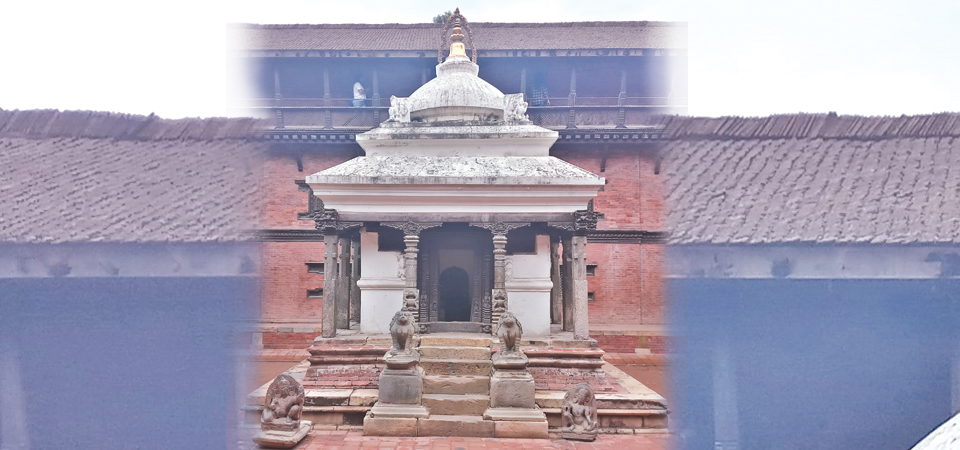Worship of Mani Keshav Narayan resumes after 40 years

By Aashish Mishra
Lalitpur, Dec. 4: It was November 15, the day of Haribodhani Ekadashi, and the main courtyard behind the golden gate of Patan Museum was abuzz with activity. The chowk is almost always busy, made lively by the domestic and international tourists visiting the gallery dubbed one of the finest museums of South Asia. But this day was livelier than usual.
It was because members of the Mani Chhén Brahman clan were conducting a special Kshyama Puja (forgiveness worship) to the deity after whom the courtyard is named – Mani Keshav Narayan; the significance of the occasion was not lost on anyone. It was the first Puja – of any kind – the God housed in the typical single-storey domed-roof white temple located on the premises had received in more than four decades.
“The last time the Narayan here had been worshipped was in the 1970s,” informed Suresh Man Lakhey, acting executive director of Patan Museum. “This makes it all the more wonderful that we have been able to restart daily worship here.”
Mani Keshav Narayan is an important deity of Patan, believed to have been established in the Patan Durbar complex by Lichhavi rulers who entrusted its worship and management to their Rajopadhyaya gurus. These Rajopadhyayas, of the aforementioned Mani Chhén clan who live near the Patan Durbar Square, continued to perform the religious rituals related to the God throughout the centuries without any hindrance.
“But from the 1950s onwards, we started losing access to the temple,” shared Madhav Shyam Sharma, a descendant of the Rajopadhyaya priests of Keshav Narayan and member of the Mani Chhén group. “During the premiership of Dr. KI Singh, the courtyard became the living quarters of the then Mukti Sena (the militant wing of the Nepali Congress) and entry to outsiders was prohibited. Then, in the 1960s, the buildings of Patan Durbar were turned into various government offices and the priests were only allowed in during office hours.”
“These restrictions made us unable to reach the temple which was, figuratively, right in front of us and the worship stopped,” Sharma, who is also the priest of Kumbeshwor Mahadev, explained.
And that was how it remained for more than 40 years until this year, when Patan Museum decided to ‘restore’ the temple’s life. “As a museum, we felt it was our responsibility to not only preserve the tangible monuments but also the intangible culture of the community,” Acting Executive Director Lakhey said.
Under this responsibility, the museum, hoping to resume daily worship at the temple, started looking for the former Pujaris and approached the Mani Chhén family who were more than happy to reassume their priestly role.
Shivesh Sharma, Madhav Sharma’s nephew and one of the new Pujaris of Mani Keshav Narayan, called it an emotional moment. “It was a long wait, of nearly half a century, and I have no words to describe our happiness at being able to worship this Narayan again,” he said, adding that the clan would not let the Nitya Puja stop again.
As a token of support, the Museum has also allocated a nominal budget to help cover the costs of daily worship, Lakhey informed.
Mani Keshav Narayan is one of the eight ‘Manis’ located in Patan Durbar Square, with the other seven being Mani Ganesh, Mani Chaitya, Mani Chhén, Mani Bhairav, Mani Mandap, Mani Lingeshwor and Manga Hiti. These eight Manis are what give Manigal (Mangal/Mangalbazaar) its name.
On a related note, Patan Museum also started the worship of the 14th-century Sadashiva idol, located inside the Bhandarkhal garden, from Shivaratri last year and plans to restart worship of several other gods and goddesses under its management in the coming future.
Recent News

Do not make expressions casting dout on election: EC
14 Apr, 2022
CM Bhatta says may New Year 2079 BS inspire positive thinking
14 Apr, 2022
Three new cases, 44 recoveries in 24 hours
14 Apr, 2022
689 climbers of 84 teams so far acquire permits for climbing various peaks this spring season
14 Apr, 2022
How the rising cost of living crisis is impacting Nepal
14 Apr, 2022
US military confirms an interstellar meteor collided with Earth
14 Apr, 2022
Valneva Covid vaccine approved for use in UK
14 Apr, 2022
Chair Prachanda highlights need of unity among Maoist, Communist forces
14 Apr, 2022
Ranbir Kapoor and Alia Bhatt: Bollywood toasts star couple on wedding
14 Apr, 2022
President Bhandari confers decorations (Photo Feature)
14 Apr, 2022










